Introduction: In this article, Melissa Davenport Berry continues her series profiling descendants of the Mayflower settlers, concluding her focus on former lieutenant governor and president of the Massachusetts Mayflower Society Dr. Rev. Robert Merrill Bartlett of Plymouth, Massachusetts. Melissa is a genealogist who has a blog, AnceStory Archives, and a Facebook group, New England Family Genealogy and History.
Today I continue my story of Dr. Rev. Robert Merrill Bartlett (1898-1995), 10th in descent from Mayflower passenger Robert Bartlett, who married Mary Warren, daughter of Mayflower passenger Richard Warren. In 1970 Rev. Bartlett was a very busy man for all things Mayflower, and served as regional chairman of the Pilgrim 350th Anniversary Committee.
He was a guest of officials in Rotterdam, Holland, where he lectured on Pilgrim history. This was just one of his labors of love in the name of Pilgrim preservation. The Naples Daily News published a story, “Mayflower Descendants To Sail Across Atlantic,” which covered Bartlett’s 34-day venture on the M. S. Kungsholm, a Swedish luxury liner which followed in the wake of the Pilgrims’ journey aboard the Mayflower.
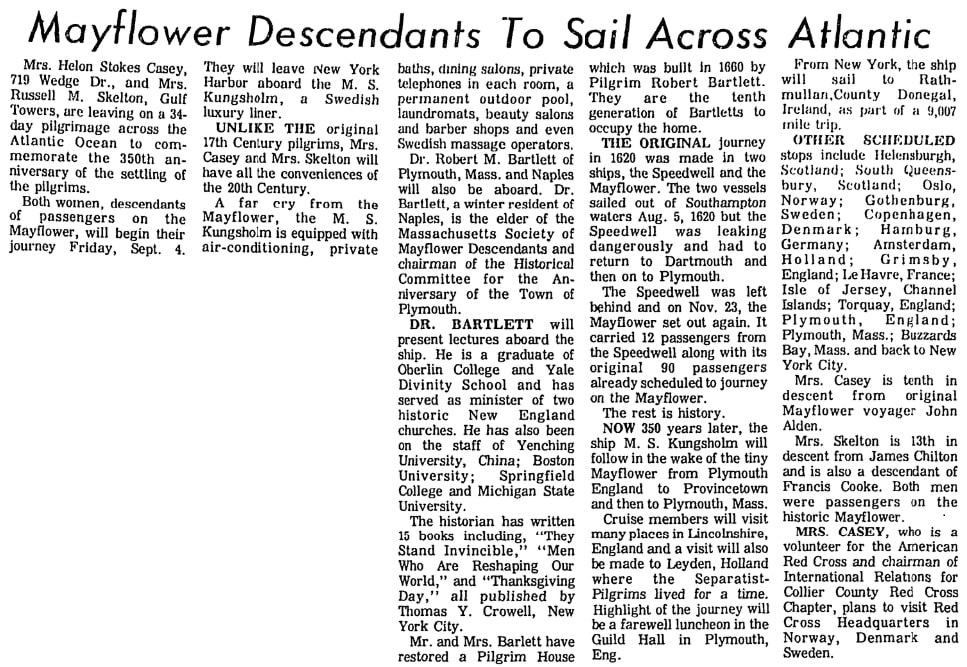
In addition to Bartlett, the article featured two other travelers: Mrs. Russell Mack Skelton, born Bonnie F. Edmonds, daughter of Clifton Edmonds and Dolly Anderson, 13th in descent from Mayflower passenger James Chilton, with a connection to Francis Cooke; and Mrs. Helon M. Stokes Casey, wife of Eugene Bernard Casey, born to Charles H. Stokes and Minnie D. Hart, 10th in descent from Mayflower passenger John Alden.
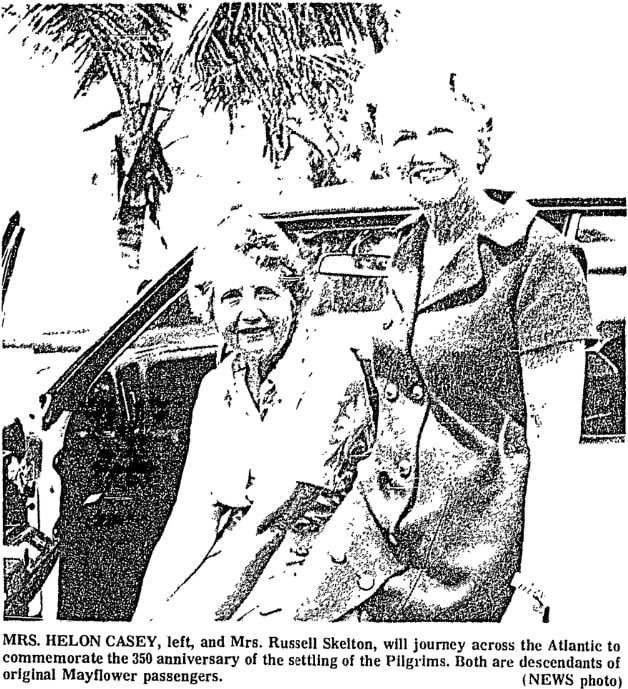
During the voyage over, Bartlett gave talks on the Separatists Pilgrims: In 1607 and 1608 under King James I, the Pilgrim Separatists suffered persecution and fled to Holland. A party including Brewster, Bradford, and other leaders boarded a Dutch ship at a place called Scotia Creek near the port of Boston, England, in 1607. The captain of the ship betrayed them to the authorities, and they were imprisoned. After their release, the Pilgrims secured another ship that took them to Holland in 1608. You can read more in Rev. Bartlett’s book, The Pilgrim Way.
During the 1970 commemorative trip, Rev. Bartlett and the group visited the Pilgrim Fathers Memorial in England at Immingham Creek, erected in 1924.
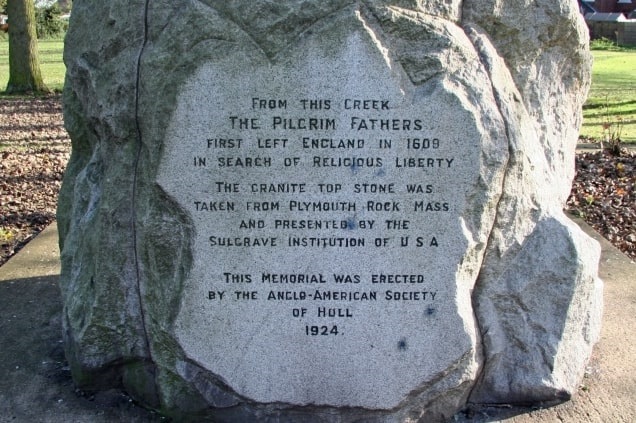
The inscription reads:
“From this creek the Pilgrim Fathers first left England in 1609 [1608] in search of religious liberty. The granite top stone was taken from Plymouth Rock, Mass., and presented by the Sulgrave Institution of USA. This memorial was erected by the Anglo-American Society of Hull, 1924.”
A photo published in the Repository shows Cadet Bradford of the U.S.S. Nantucket, a direct descendant of Mayflower passenger William Bradford, laying a wreath on the monument to honor his ancestor in 1924.
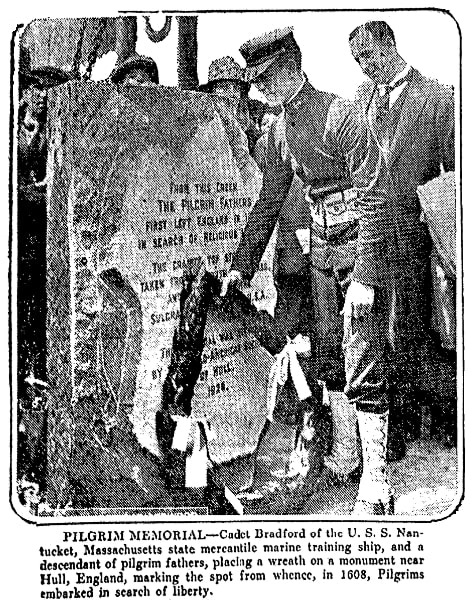
The Patriot Ledger featured a photo of Bartlett with Rabbi Rudolph J. Loebel, from the Congregation Beth Jacob of Plymouth. The two men stand before the monument erected at the grave of William Bradford, who served as governor of Plymouth Colony from 1621-1657.
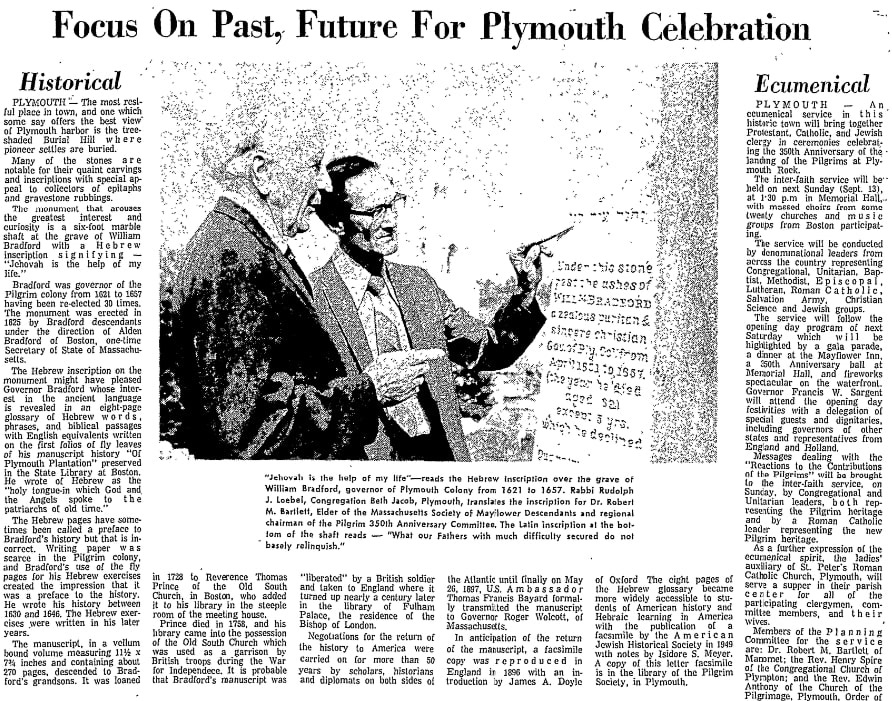
This article reports:
“The monument that arouses the greatest interest and curiosity is a six-foot marble shaft at the grave of William Bradford with a Hebrew inscription signifying: ‘Jehovah is the help of my life.’”
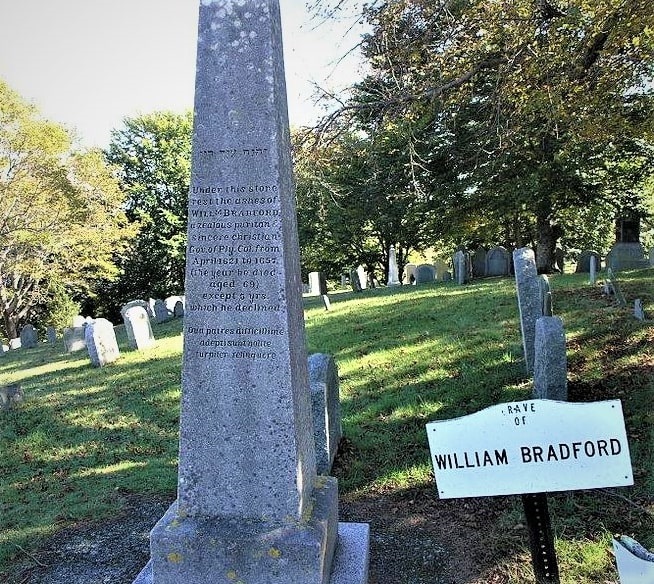
The article reports:
“The Hebrew inscription on the monument might have pleased Governor Bradford, whose interest in the ancient language is revealed in an eight-page glossary of Hebrew words, phrases and biblical passages with English equivalents written on the first folios of fly leaves of his manuscript history ‘Of Plymouth Plantation’ preserved in the State Library at Boston. He wrote of Hebrew as the ‘holy tongue in which God and the Angels spoke to the patriarchs of old time.’”
Bradford’s manuscript history descended to his grandsons.
The article reports:
“It was loaned in 1728 to Reverence Thomas Prince of the Old South Church, in Boston, who added it to his library in the steeple room of the meeting house.
“Prince died in 1758, and his library came into the possession of the Old South Church which was used as a garrison by British troops during the War for Independence. It is probable that Bradford’s manuscript was ‘liberated’ by a British soldier and taken to England, where it turned up nearly a century later in the library of Fulham Palace, the residence of the Bishop of London.
“Negotiations for the return of the history to America were carried on for more than 50 years by scholars, historians, and diplomats on both sides of the Atlantic until finally on May 26, 1897, U.S. Ambassador Thomas Francis Bayard formally transmitted the manuscript to Governor Roger Wolcott, of Massachusetts.”
You can see the manuscript now housed at the Pilgrim Museum.
Stay tuned for more!
Note on the header image: Mayflower 1970 commemorative stamp. Permission to publish courtesy of: Nigel Montgomery of the Philatelic Heritage, 35a High Street, Hungerford, RG17 0NF, United Kingdom.
Note: An online collection of newspapers, such as GenealogyBank’s Historical Newspaper Archives, is not only a great way to learn about the lives of your ancestors – the old newspaper articles also help you understand American history and the times your ancestors lived in, and the news they talked about and read in their local papers. Do you have a family connection all the way back to the Mayflower Pilgrims?
Related Articles:
- Mayflower Descendants: Who’s Who, Part I
- Mayflower Descendants: Who’s Who, Part II
- Mayflower Descendants: Who’s Who, Part III
- Mayflower Descendants: Who’s Who, Part IV
- Mayflower Descendants: Who’s Who, Part V
- Mayflower Descendants: Who’s Who, Part VI
- Mayflower Descendants: Who’s Who, Part VII
- Mayflower Descendants: Who’s Who, Part VII (conclusion)
- Mayflower Descendants: Who’s Who, Part 8
- Mayflower Descendants: Who’s Who, Part 9
- Mayflower Descendants: Who’s Who, Part 10
- Mayflower Descendants: Who’s Who, Part 11
- Mayflower Descendants: Who’s Who, Part 12
- Mayflower Descendants: Who’s Who, Part 13
- Mayflower Descendants: Who’s Who, Part 13 (conclusion)
- Mayflower Descendants: Who’s Who, Part 14

I believe I have a connection from my grandmother Lola Jane Cleveland to William Cleveland (1719-1790), son of Lucy Fitch (1698-1770), daughter of Alice Bradford (1661-1745), daughter of William Bradford Jr. (1624-1703), son of William Bradford (1598-1657) and Alice Anne Carpenter (1590-1670).
Hello Gerald,
Thanks for sharing! I will check out any stories on this Mayflower line. Stay tuned for more!
Great series Melissa, thank you for keeping and bringing our history to life.
Thanks Elizabeth, and I appreciate you sharing the stories on your Mayflower Group page.